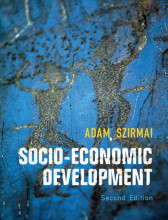Structural change and industrialization
8 important questions on Structural change and industrialization
Is manufacturing more important for growth than services?
Service-led growth: it is seen quite negative
- Marxists: productivity slowdown of the Western economies was caused by the rise of the service sector
- Sector could only develop once industrial sector had been sufficiently developed
- Labour intensive so productivity can’t increase through automation or the use of capital
Recently it is seen more positively: it can be an engine of regional and national growth, services and manufacturing reinforce each other.
Discuss four different kinds of sectoral classifications which are relevant for our understanding of structural change.
- Primary: food, crops, fishing, forestry, mining
- Secondary: uses primary products and converts them into manufactured products
- Tertiary sector: service activities, produces intangibles
Agriculture, industry and services:
- Agriculture: also hunting, fisheries and forestry
- Industry: secondary sector plus mining
-Services
Traditional sector versus the modern commercial sector:
- Traditional sector: agriculture, traditional crafts production and the rural and urban informal sector
- The modern sector: manufacturing, construction and mining, commercial agriculture and formal service activities
The rural sector versus the urban sector:
- Urban: higher population densities, more industrial activities
- Rural: lower population density, agricultural activities
How does the pattern of structural change in developing countries since 1950 differ from earlier patterns of structural change in presently advanced economies?
- Because Western countries were first to industrialise, and developing countries had to compete as latecomers in a highly competitive market.
- Pre-mature de-industrialization: de-industrializing while being at a lower level of per capita income, normally de-industrialization occurs at a high per capita income.
- Higher grades + faster learning
- Never study anything twice
- 100% sure, 100% understanding
Why is a balance between the agricultural sector and the industrial sector considered to be advantageous for economic development in later stages of development?
-There are complementarities between agriculture and industry.
What are the main characteristics of the vent for surplus model of primary exports?
Factors that allow country to benefit from export opportunities:
- Availability of surplus land
- Access to surplus land
- Availability of water
- Government policy
- Establishment of internal law and order
To what extent did primary exports contribute to the economic dynamism of developing countries between 1870 and 1913?
- But primary exports encourages inflow of foreign capital and increases domestic savings and immigration of labour. This leads to higher competition on world markets and increased productive efficiency, which increases dynamic comparative advantages
Discuss the Prebisch-Singer theory of declining terms of trade for primary products. To what extent is the Prebisch-Singer theory still relevant today?
- Because the value of wages in the advanced countries will increase relative to wages in the export sector for developing counties
Rich countries benefit more from international trade than poor countries.
Why is an agricultural surplus often considered to be a precondition for industrialisation?
Why should agricultural stagnation affect the prospects of industrialisation negatively?
-Transfers in a stagnant agricultural sector leads to impoverishment of the rural population.
The question on the page originate from the summary of the following study material:
- A unique study and practice tool
- Never study anything twice again
- Get the grades you hope for
- 100% sure, 100% understanding
































